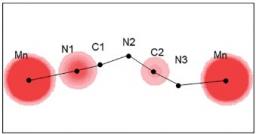Béatrice Gillon, Albert Hammerschmied, Arsen Gukasov, Alain Cousson, Thomas Cauchy, Eliseo Ruiz, John A. Schlueter, Jamie L. Manson
We report neutron‐diffraction investigations of the quasi‐2D MnII(dca)2(pym)(H2O) (pym = N2C4H4) compound, where high‐spin MnII ions are bridged by dicyanamide anions, [N(CN)2]– (herein abbreviated dca). Inside the layers, Mn2+ ions are connected by single or double dca bridges. The magnetic phase diagram was established by neutron diffraction on a single crystal. In the low‐field phase, the MnII ions are antiferromagnetically ordered in the layers, with moments nearly parallel to the c axis, and the layers are antiferromagnetically coupled. The spin‐flop phase corresponds to ferromagnetic coupling between the antiferromagnetic layers, in which the MnII moments are nearly perpendicular to the c axis. The induced spin‐density distribution in the paramagnetic phase, determined by polarized neutron diffraction, visualizes the superexchange pathways through the dca ligands within the layers and through H bonding between neighboring layers. The theoretical spin density obtained by bidimensional periodic DFT calculations is compared with the experimental results. Furthermore, quantum Monte Carlo simulations have been performed to compare the DFT results with experimental susceptibility measurements.









 Materials for new energy technologies
Materials for new energy technologies
